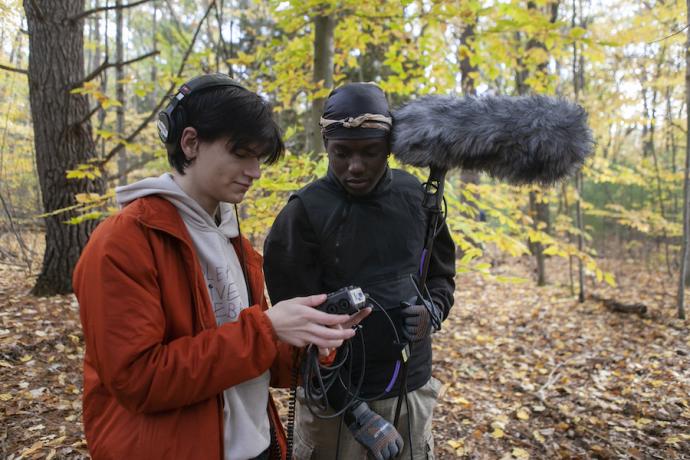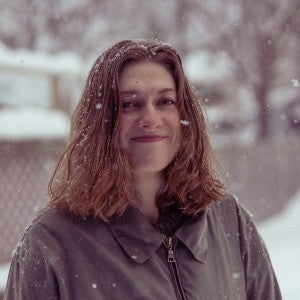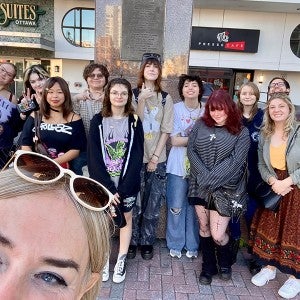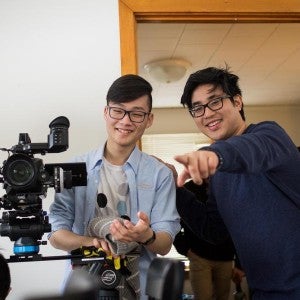Cinema Collective unites alumni, faculty, students, and guests to develop original visual stories
The Collective facilitates opportunities for alumni engagement, professional development, mentorship, and hands-on learning by producing fully realized professional film projects on Interlochen’s campus.

When Michael Mittelstaedt arrived at Interlochen in 2005 to lead the institution’s new Film & New Media division, he was already envisioning an era in which Interlochen-trained filmmakers would return to campus to work with the next generation of film students.
“When I was hired, my goal for the Film & New Media curriculum was to share visual storytelling in a way that would build a generation of community-minded filmmakers who would want to come together as future collaborators,” Mittelstaedt said. “I wanted to instill values, skills, and stories in these young filmmakers so that when we invited them back to Interlochen as industry professionals, it would be a gift to collaborate with them.”
This April, Mittelstaedt’s vision came to fruition with the inaugural production of the Interlochen Cinema Collective, a group of alumni, faculty, and guest artists dedicated to the creation of fully realized professional film productions. For four days, Film & New Media students worked side-by-side with members of the Collective to complete principal photography for Jedo’s Dead, a short film written by alumna Sara Nimeh (IAC 00-06, IAA 06-08).
The Cinema Collective has two primary objectives: To develop original visual stories, and to mobilize nearly a century of Interlochen alumni as collaborators and mentors. Through the Cinema Collective, faculty, alumni, and resident artists working in many facets of the film and television industry will convene at Interlochen to produce short and feature-length films and work with Interlochen’s Film & New Media students.
“The Collective has been a long time coming,” Mittelstaedt said. “It really pushes the boundaries of what Interlochen is capable of doing.”
The beta project: Chasing Daylight
In 2015, Mittelstaedt reached out to several Film & New Media alumni about the possibility of collaborating on his original film, Chasing Daylight.
“I knew that we were coming to a time in the history of the Film & New Media division when many of our alumni were beginning their professional careers,” he said. “I realized they were going to be incredible collaborators on this project.”
Over the course of the next year, Mittelstaedt and a core group of alumni—including Chad Engel (IAA 07-09), Dylanger Bates (IAC 07, IAA 07-09), and Nimeh—discussed plans for shooting the film. Mittelstaedt was awarded a sabbatical, and in 2016, Chasing Daylight began production on location near Palmdale, California. The production provided an ideal environment for testing the Cinema Collective concept.
“Working on Chasing Daylight renewed my energy and inspired me to keep thinking about what the Cinema Collective might be,” Mittelstaedt said. “Collaborating with my former students showed me that what I had anticipated in terms of the sentiment and the ability of the alumni was true. We could get together and create things that had a high standard without the crazy budgets and time crunches.”
The inaugural season: Jedo’s Dead
Shortly before the COVID-19 pandemic, Mittelstaedt secured the funding needed to make the Cinema Collective a reality. Although the pandemic stalled efforts to bring alumni and guests to campus, Mittelstaedt moved forward, officially launching the Collective in 2020.
About a year ago, Mittelstaedt and a small group of Film & New Media alumni began meeting weekly to incubate screenplays for future Cinema Collective projects.
“During that time, we were thinking about screenplays, talking about stories, and giving each other feedback,” he said.
Eventually, Nimeh’s script, Jedo’s Dead, was selected as the Collective’s inaugural project.
“Sara’s screenplay arose out of our discussions based not only on the quality of the story, but also because it takes place in a single location with just three characters,” Mittelstaedt said. “It’s a story that is ambitious, yet is reasonable for us to achieve in a short amount of time.”
With the script selected, Mittelstaedt, with the help of Collective members, put out a call to alumni, inviting them to take part in the project.
“I got a great deal of response, and although not all those who responded were able to be involved right away, it was heartening to see the support that people were sharing and the suggestions of how they might become involved later,” Mittelstaedt said.
In April, a small team of alumni and visiting filmmakers convened at Interlochen to shoot Jedo’s Dead. The crew featured, among others, Mittelstaedt as executive producer, Nimeh as director, Shane Bagwell (IAA 15-17) as director of photography, Ellyn Church (IAA 06-07; IAC St 07, 09, 11) as producer, and Bates as production designer and props master. Twelve Film & New Media students served as production assistants.
“Although ‘production assistant’ sounds like a low-level position, the students were very well-ingrained production assistants,” Mittelstaedt said. “They were able to get hands-on learning with lighting, camera, production, design, set decoration—all manner of roles on set. During the four days we shot, as well as the two or three days prior, they were doing all of the prep work on location. They were very close to the action.”
The future of farming and filmmaking: The Greenacres documentary
Students will also be heavily involved in the Collective’s next project: A collaboration with the Ohio-based Greenacres Foundation. Through the partnership, Interlochen Arts Academy students and faculty members will create a documentary about regenerative agriculture practices.
“The Greenacres project is going to be a longer-format project, a feature that will take a couple of years to complete,” Mittelstaedt said. “We’ll be learning about how we can take care of the earth and how taking care of the earth takes care of us. My pitch for the documentary is that the earth is the only story we all share.”
“Making this concept accessible is the key—it’s a matter of finding the story inside to make sure our audiences understand the importance of what we’re trying to share.”
The documentary will begin production in Fall 2023. The Film & New Media division will welcome several new instructors to assist with the film’s creation.
“We are hiring a new faculty member who will be teaching within their expertise while also thinking about creative direction for the documentary,” Mittelstaedt said. “We’ll also be hiring a producer and a cinematographer. These faculty will not only be teaching classes for Film & New Media students, but also working in development on the Greenacres project. It’s a slightly different design from other Cinema Collective projects, but it still follows the idea of students and faculty working side-by-side to create new work.”
As a documentary, the Greenacres project will also follow a different life cycle than a typical Cinema Collective project.
“It’s a bit of an inverted process in that the filmmakers will be looking for the story instead of writing it,” Mittelstaedt said. “It’s a gift for our students to be able to learn how to create both narrative fiction work and documentaries.”
Once completed, the Greenacres documentary will be shared with the public via streaming platforms and community screenings. Mittelstaedt also hopes to showcase the film at national film festivals.
Looking ahead
Through Chasing Daylight and Jedo’s Dead, Mittelstaedt has refined his aspirations for the Cinema Collective.
“What I learned is that we need more time, more preparation, and a little bit more diversifying of voices,” Mittelstaedt said.
While this season’s crew was in residence for only a few days, Mittelstaedt hopes future Cinema Collective guests will serve longer-term commitments.
“It’s crucial to the Collective that crew members come back to campus with enough time to work with students,” he said. “This year, Cinema Collective members worked with 12 of our 28 Film & New Media students on set. While there were some conversations off set, I’d like the front-end crew to come in early enough that all students in the department get to hear from these alumni and learn what they’re doing in their work. Eventually, the hope would be that anybody working in development on a project would come for several weeks to a semester and would act as a mentor and resident artist.”
As resident artists, Cinema Collective guests will teach arts electives in their area of expertise. These electives, which will be open to students of all majors, will enable the Film & New Media division to supplement its existing curriculum with courses in subjects such as editing, sound recording, cinematography, producing, and arts business/finance.
Mittelstaedt also plans to recruit larger, more diverse production teams for future projects by leveraging Interlochen’s extensive alumni network.
“My hope is that these productions will be crewed and casted primarily by Interlochen or Interlochen-affiliated collaborators,” Mittelstaedt said. “The Film & New Media program has been here 18 years, and we have a lot of alumni we can count on. But prior to those 18 years, there were thousands of actors, musicians, and all kinds of artists who trained at Interlochen. I think we can spread the net a little wider and find out who else is acting, performing, designing, and casting. In this upcoming season, we want to put out a call for crew members, designers, and other collaborators much earlier.”
Collaborating across generations
By putting out a wider call, Mittelstaedt can achieve another goal: Creating a team that includes artists of all ages.
“My intention is for the Cinema Collective to be an intergenerational creative collision,” Mittelstaedt said. “This season, my youngest student on set was 14; my oldest crew member was 58; my oldest actor was around 70; and our youngest actor was seven. The Cinema Collective is not just about teenagers and young adults making movies, it’s a community for all kinds of members: teenagers and young children and elderly people.”
“This is an endeavor that is compassionate. We can be many ages, and live in many places, but we’re all coming together to tell a story.”





